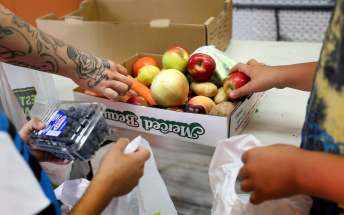Satisfying hunger with dignity Affordable-food sales and food clubs fill the need for the working poor and neighbourhoods with high rates of child poverty
Read this article for free:
or
Already have an account? Log in here »
To continue reading, please subscribe:
Monthly Digital Subscription
$19 $0 for the first 4 weeks*
- Enjoy unlimited reading on winnipegfreepress.com
- Read the E-Edition, our digital replica newspaper
- Access News Break, our award-winning app
- Play interactive puzzles
*No charge for 4 weeks then billed as $19 every four weeks (new subscribers and qualified returning subscribers only). Cancel anytime.
Read unlimited articles for free today:
or
Already have an account? Log in here »
Hey there, time traveller!
This article was published 19/09/2019 (1678 days ago), so information in it may no longer be current.
With $350 to spend and no time to waste, Melissa McDonald wheels a heavy platform cart into cold storage, greeting staff at the grocery store on the way in.
Surrounded by towers of cardboard boxes full of apples, peaches and bell peppers, the North End Food Security Network co-ordinator is at the centre of a speed-round shopping spree to buy bulk produce on a budget.
Food policy council ‘finally moving’
It wasn’t always an easy sell at city council, but funding has been approved for the first food and agriculture strategy. By the end of this year, a final report is expected to detail Winnipeg’s food security issues ward by ward, and set out a plan to deal with them.
“We’re finally moving,” says St. Vital Coun. Brian Mayes, chairman of the Winnipeg Food Policy Council. The citizens advisory group has been in the works since 2015 and was officially formed in 2017, but it wasn’t until the city agreed this spring to spend roughly $20,000 to fill a six-month research position that work began in earnest, he said.
Food Matters Manitoba, a non-profit organization, will produce the final report.
It wasn’t always an easy sell at city council, but funding has been approved for the first food and agriculture strategy. By the end of this year, a final report is expected to detail Winnipeg’s food security issues ward by ward, and set out a plan to deal with them.
“We’re finally moving,” says St. Vital Coun. Brian Mayes, chairman of the Winnipeg Food Policy Council. The citizens advisory group has been in the works since 2015 and was officially formed in 2017, but it wasn’t until the city agreed this spring to spend roughly $20,000 to fill a six-month research position that work began in earnest, he said.
Food Matters Manitoba, a non-profit organization, will produce the final report.
Lobbying to lower water-usage rates for community gardens is one of Mayes’ top priorities, followed by dealing with longtime food deserts — areas where there are no grocery stores — as well as trying to make public transit more accessible. Mayes said he would support property-tax waivers under certain conditions.
“Could we do that to attract a grocery store where we’ve got a food desert? I don’t know that my colleagues would agree with that, but that’s the kind of thing I want to look at,” he said.
Acknowledging the “pockets of poverty” that exist in his own neighbourhood and other areas in the city, Mayes said he’s been fighting to ensure that the food council is taken seriously. Winnipeg has lagged behind other cities, including Edmonton and Ottawa, in developing its own food strategy.
“The mayor has been supportive (and) I want to give credit for that. Some others have been more skeptical,” he says.
Although he’s not much of a gardener, Mayes found himself to be an unlikely champion of policies that encourage residents to grow their own food. He’s learned that a municipal food strategy can go far beyond that.
“If you’d asked me a couple of years ago, I’d say wow, that sounds flaky, a food council, but you know, you start getting into it and it’s pretty meaningful,” he said. “There are environmental aspects, there are anti-poverty aspects, there are nutritional aspects, so I think the time has come to be doing this for the city. And I’m just very pleased that we finally got the resources and we’re going to move forward.”
The council includes citizen members and representatives from the Winnipeg Regional Health Authority and the food-production industry. A rep from the provincial government was initially appointed for a two-year term, which is set to expire in 2020, but the province is no longer involved.
Provincial leadership is necessary to address the causes of food insecurity and support local groups that are doing on-the-ground work, said Rob Moquin, policy director for Food Matters Manitoba.
“There’s a disconnect between what we recognize as the issue and solution, and what we’re willing to implement in our legislatures,” he said. Although Manitoba has acknowledged the link between food security and poverty, its responses have been “quite thin,” Moquin said.
“The province really needs to step up and say, this is an income issue. We need to think of income supports that ensure that people have the resources that they need to eat well, and in the meantime, we need to support the initiatives that people are doing immediately to meet people’s needs.”
“We’re going to do this fast,” Mike Hemminger tells her. He’s a produce manager at the Dufferin Avenue Sobeys Cash & Carry, where McDonald has been shopping about once a month for the past four years. It’s 9:30 a.m. on a Tuesday, and Hemminger is ready.
“I know what it costs. I know what I can sell, and it’s going to a good cause,” he says.
Over the hum of the industrial refrigerators, he calls out the specials and most popular staples.
“Carrots!”
“We’re going to do some Mac apples!”
“Peaches!”
Hauling over crate after crate of fruit and vegetables, he plunks them onto the cart when McDonald gives him the nod.
After some quick math and a crate each of broccoli, potatoes, pears, cauliflower, tomatoes and plums, Hemminger announces they’ve almost hit the budget. He tosses a 50-pound bag of onions on top of the pile and throws in 24 pints of blueberries for free.
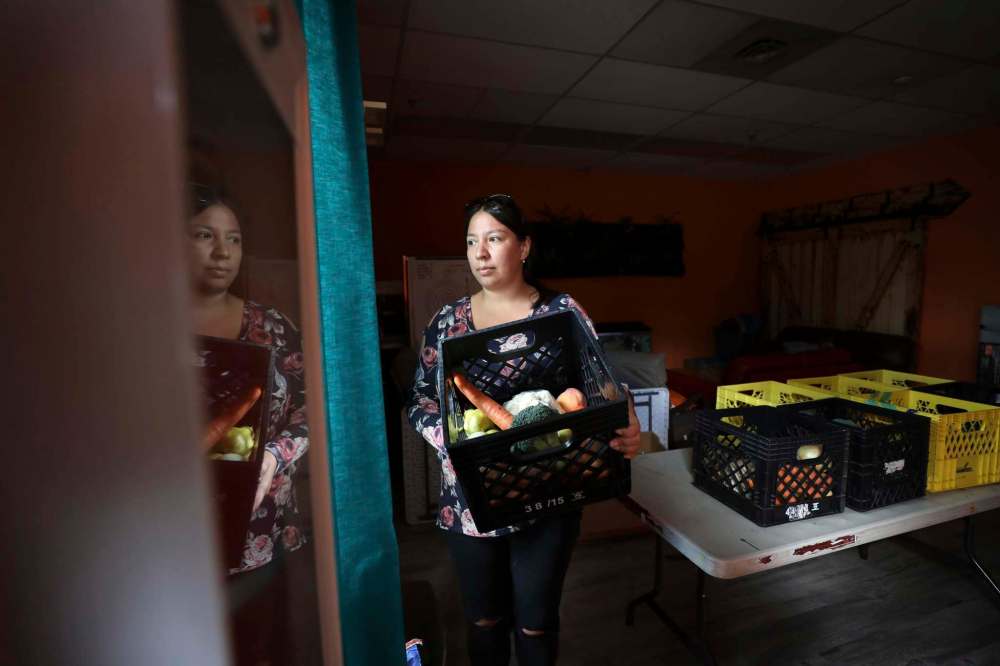
Within 15 minutes of walking into the store, McDonald and her haul are headed back to the heart of the North End, where she’ll sort the fruit and vegetables and sell them for half of what they’d cost at a grocery store.
“People just know my face and they know, ‘oh, there’s the food lady!’ It feels good to be known as someone who’s there to help you eat healthy and find affordable, healthy food,” says McDonald, who works for the North End Community Renewal Corp.
“Everyone deserves food; healthy food, that is, no matter where they live or what their ethnicity or how much they make every two weeks, you know?”
Hers is one of a handful of affordable-food sales that have cropped up across the city in the past few years. Operating separately with very little funding and with lots of help from volunteers, they each sell fresh food at-cost to combat rising produce prices and a lack of grocery stores in their neighbourhoods.
Systemic policy changes missing
The pinch of sharp increases in the price of groceries may be felt deeply across the Prairies, but reliable data that shows how much food costs in Manitoba can be hard to come by.
Produce prices in Canada have spiked by nearly 20 per cent since last year, according to Sylvain Charlebois, senior director at Dalhousie University’s Agri-Food Analytics Lab. Over the 20 years he’s been researching Canada’s food security and distribution issues, the biggest change he’s seen in the field is price volatility.
“The prices are almost unpredictable,” he says, particularly for bread and produce. More innovation in federal trade policies is necessary to grow, Charlebois adds, “To feed ourselves and feed the world. We have cheap space, we have cheap land, we have cheap feed, and we have… great research.”
The pinch of sharp increases in the price of groceries may be felt deeply across the Prairies, but reliable data that shows how much food costs in Manitoba can be hard to come by.
Produce prices in Canada have spiked by nearly 20 per cent since last year, according to Sylvain Charlebois, senior director at Dalhousie University’s Agri-Food Analytics Lab. Over the 20 years he’s been researching Canada’s food security and distribution issues, the biggest change he’s seen in the field is price volatility.
“The prices are almost unpredictable,” he says, particularly for bread and produce. More innovation in federal trade policies is necessary to grow, Charlebois adds, “To feed ourselves and feed the world. We have cheap space, we have cheap land, we have cheap feed, and we have… great research.”
“If we have a comprehensive, strategic approach to global trades and food, I think we can actually grow our economy, make our people more food secure and also become an agricultural powerhouse that we should be for the world. And right now, we’re not.”
Systemic policy changes are missing from the federal food policy announced in June, Charlebois said, but they are what’s necessary to deal with food security.
At the provincial level, Manitoba has not produced a final report on grocery pricing in the province since 2011. The nutritious food basket data is based on a standard Health Canada list of foods. The provincial government collected updated data as recently as 2017, but it hasn’t been released.
Advocates have long been pushing the province to release the data. Among them is Joyce Slater, an associate professor in University of Manitoba’s Department of Food and Human Nutritional Sciences.
“How would you calculate how much the cost of living is if you don’t know how much it costs for groceries?” Slater says.
Having that data would help support non-profits who are doing a lot of heavy lifting to help people in their neighbourhoods get fresh, affordable, healthy food.
“Where are we connecting up the dots? We can’t talk about food security without talking about housing, transportation, mental health,” Slater says. “They’re all connected.”
AFFORDABLE FOOD SALES
North End Food Security Network indoor food market
Happens year-round at the Indigenous Family Centre, 470 Selkirk Ave.
Runs monthly, on days that child-tax benefits are paid out by the government, starting 12:30 p.m.
For more information: https://www.facebook.com/nefsn/
Better Access to Groceries program
Happens year-round for Elmwood residents
Runs every second Tuesday 1:30-6:30 p.m. at Chalmers Community Centre, 480 Chalmers Ave.
For more information: http://chalmersrenewal.org/bag/
West Broadway Good Food Club farmers market
Happens outdoors in summer every Wednesday at the West Broadway Community Organization (now at 222 Furby St.) from 3 p.m. to 6 p.m.
Happens indoors in winter every second Wednesday at 185 Young St., 3 p.m. to 6 p.m.
For more information: http://www.westbroadway.mb.ca/
Seven Oaks Better Access to Groceries Program
For more information: https://www.facebook.com/groups/1607558602870611/
Governments have promised to tackle food insecurity, since one in eight Canadian households (about four million people) doesn’t have reliable access to nutritious, affordable food. In the absence of systemic solutions from governments, local groups have stepped in. Demand for their services has increased, along with retail prices, but their work is sometimes seen as a Band-Aid to a problem that stems from longstanding poverty, low wages and and increasing cost of living. They are hungry for change that targets the root causes of poverty.
Change could be on the horizon.
Canada’s first national food policy launched in June with $134.4 million in federal funding. Most of the money is earmarked for “local food infrastructure” such as upgrading refrigerators in food banks. The federal government has promised to start a cross-country meal program in schools. But it doesn’t get at deeper issues such as the environment, agriculture, support for farmers or the effect of the country’s trade deals. It does, however, say Canada will work toward the United Nations’ sustainable development targets to end hunger by 2030.
In Manitoba, which consistently has one of the highest child-poverty rates in the country, 14 per cent of households are considered food insecure, according to Statistics Canada data published by the University of Toronto’s PROOF Food Insecurity Policy Research.

During consultations for this year’s poverty reduction strategy, the provincial government was repeatedly warned about food-security concerns. Instead of presenting a new plan to address it, the March 2019 report listed two programs the province continues to support, which are both aimed at children: the Child Nutrition Council of Manitoba and the Healthy Food in Schools project.
Food security didn’t stand out as an issue in Manitoba’s recent provincial election campaign, and although the NDP, Greens and Liberals promised variations of a guaranteed basic income, which experts say would go a long way toward eliminating food insecurity, the Progressive Conservative government made no such commitment.
In Winnipeg, which has some of the neediest neighbourhoods, a food council was formed two years ago. It’s just starting to get off the ground.
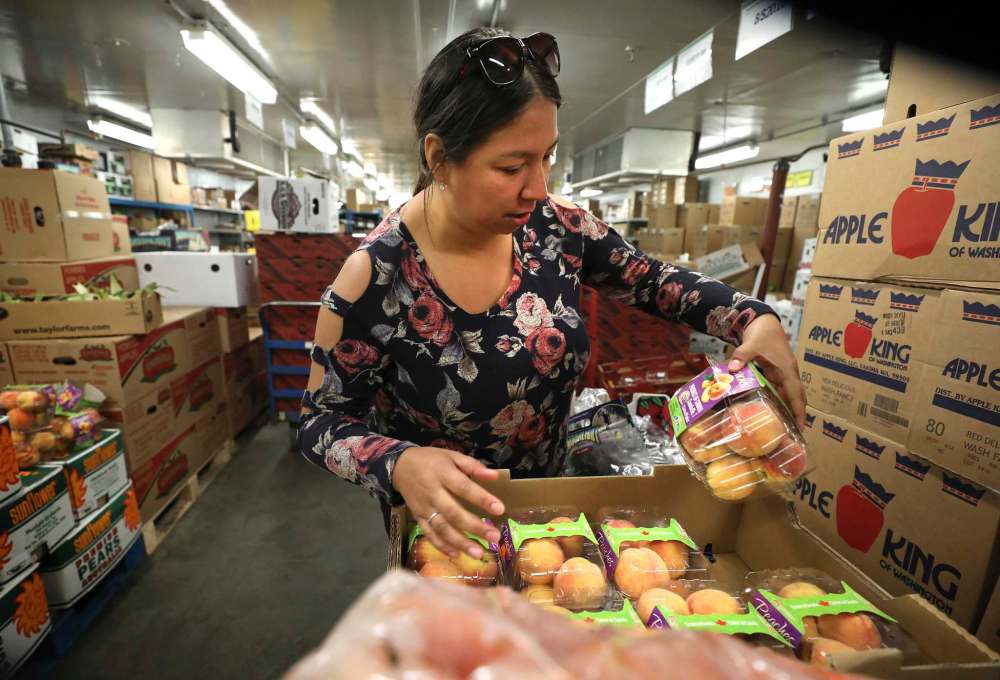
For years, the North End food sale Melissa McDonald runs has sold out in minutes, paying for itself.
Each customer pays $10 to fill their own bag with at least 10 varieties of fruit and vegetables. Since news of a good deal travels fast, people from other neighbourhoods have started showing up, too. Customers’ hearty opposition reversed an attempt to put the sale on hold during the warmer months – “people raised their voice, I guess, and said they would like to see it in the summer,” McDonald says. So it’s back by popular demand at the Selkirk Avenue Indigenous Family Centre. On this late summer day, customers start lining up an hour early to make sure they don’t miss out.
“It’s once a month, so we look forward to this day,” says Amina Kasfa, a mom of five who’s one of the first in line among mostly mothers and grandmothers. She’s learned to come early, because leaving empty-handed means she wasted bus fare.
“It’s so convenient and it’s cheap; fresh. For low-income people, for where we come from or where we live, we can’t afford to go (grocery shopping). With $10, you go to Superstore, what do you get for those $10? A grape?” she asks rhetorically, with a smile.
“That’s why we look forward (to coming). What is there for us? And the kids get so excited — ‘Oh Mommy, did you go shopping today?’ — to see the variety of the fruit and vegetables that we get.”

The peaches and pears go over well with the crowd. They usually get squeezed out of a family budget in favour of less expensive apples or bananas, says Pauline Goodvoice, a former North End resident who recently moved to St. James.
“I am going to continue to come here because it’s worth it, for sure,” she says, armed with the fresh ingredients she’ll use to make baby food.
“There’s a need throughout the entire city. It’s not just the North End that needs. People are spread out throughout the city and I think that if it (got) more attention, everybody knew about it, maybe other areas would offer the same services,” Goodvoice says.
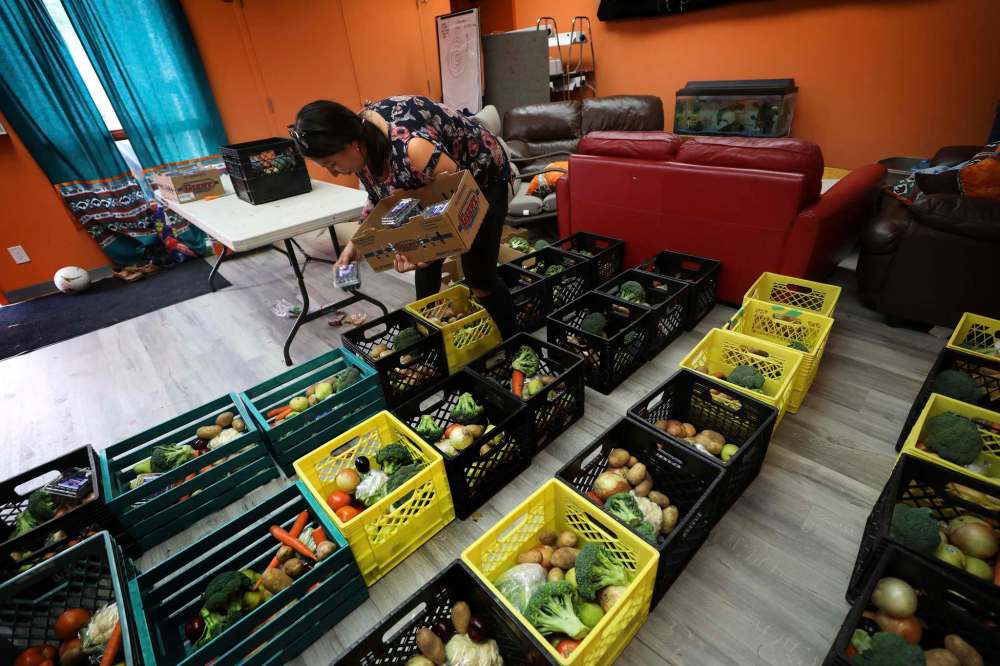
Other neighbourhoods have taken notice. An upstart operation has been running in the Seven Oaks area, and the North End food sale was inspired by a similar one in Elmwood. It started five years ago with 12 members and now serves more than 300. They also buy in bulk from Sobeys Cash & Carry, then sell the food at cost.
“Obviously, the price of groceries has absolutely changed, so that’s been a bit of a challenge in regards to keeping our budget at $10 a bag, but we’re committed to doing that, so we’ve managed to make it work,” says Jacquie Pontedeira, program co-ordinator of the groceries program at the Chalmers Neighbourhood Renewal Corp.

As the need has increased in the past few years, the biweekly sale at Chalmers Community Centre has been limited to people who live in the neighbourhood and who’ve signed up for a free membership.
There is no grocery store in the immediate neighbourhood.
It’s not a handout, and that’s what many residents appreciate – it’s more like shopping for bargain-priced healthy food with a side of social interaction for young families and newcomers to Canada.
“It builds up the community, because when they come to pick up their bag, they’re sharing with each other. If somebody says, ‘well, I don’t know what the heck to do with this,’ somebody else will pitch in,” with recipe suggestions, Pontedeira says.
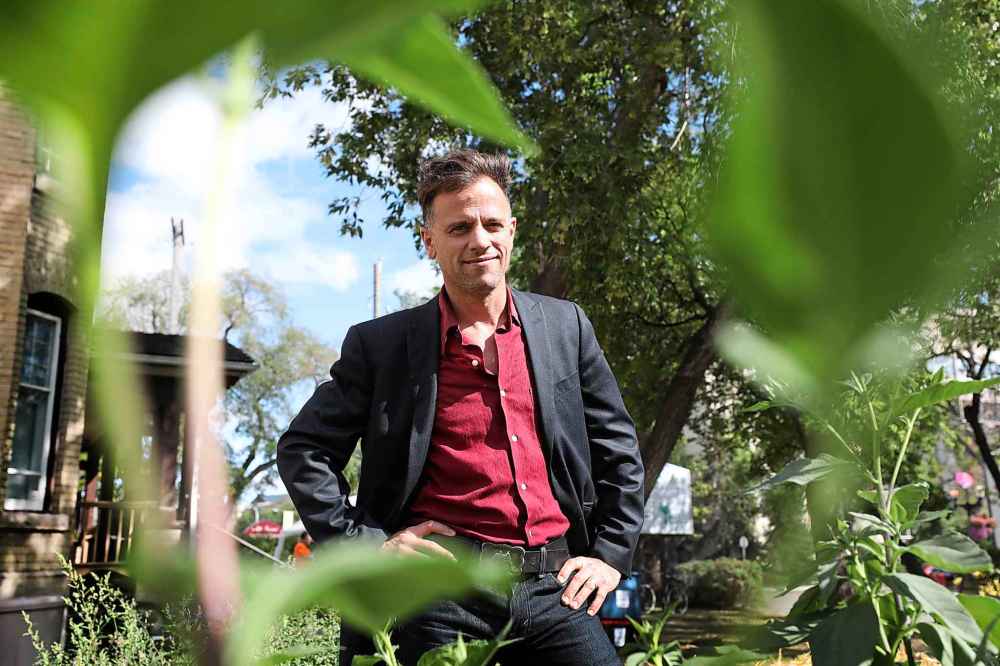
Both of those programs followed the lead of West Broadway’s Good Food Club, which took root in the neighbourhood about 17 years ago and now has 1,300 members. Its Good Food Box, a membership-based program that distributes local produce, has sprouted in other cities, including Toronto, Ottawa, Victoria and Medicine Hat, Alta. Staying true to the club’s origins, there’s no need to be a member to get access to nutritious food, says Greg MacPherson, executive director of West Broadway Community Organization.
“We fundraise to provide food to people who need it at a discounted cost, so it’s much cheaper to buy food from us here,” he says, adding the club gave West Broadway residents $12,000 worth of food last year.
“The market is really popular. It just keeps coming back because people want it, and it’s very well used. We almost always sell out all the produce that we bring in, so we’re going to keep doing that as long as we can fundraise and keep it going,” MacPherson says.

At the farmers market, held at the organization’s Broadway location on a recent Wednesday afternoon, an accordion player delights shoppers with a whimsical tune.
“We discuss the issues, we exchange really bad jokes — that’s my department,” says Yvette Berger with a laugh. She’s been a member of the Good Food Club for 10 years, and she says she returns to the year-round market as often as she can.
“This is what I like, the inclusion,” Berger says, waving to the accordion player.
“I feel it creates a win-win situation. I win by being able to save money and get access to good food (that’s) fresh, organically grown; and they make money off me so they can continue their good work.”
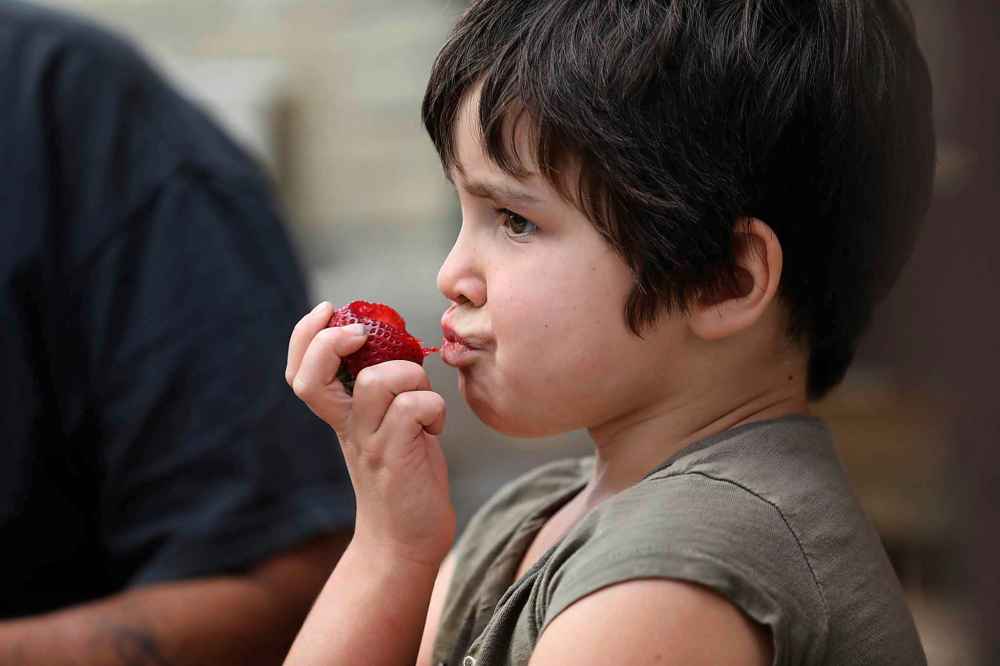
Under a tent, locally grown fare and “affordable fruit” that was purchased in bulk are sold side by side. Rex Gosselin staffs the table. Gosselin is one of several volunteers who work for points that can be spent on market vegetables. This was one of the first places Gosselin started volunteering after moving from Edmonton five years ago.
“Volunteering here actually gave me some of the gumption to work towards going back to school and getting back into work. If it wasn’t for my opportunity to volunteer here, I don’t think I’d be doing so well,” Gosselin says, adding they are on a first-name basis with regulars.
“I think for a lot of people, it’s one of their main places to get fresh fruit and vegetables. A lot of people, I think, are also going to the food bank.”

It’s been a peak summer for the former Main Meats shop at 661 Main St.; a record 170 people passed through its doors in a couple of hours on a recent Thursday.
The market has been transformed into a brightly lit space. Custom-built counters conceal spice drawers, chest freezers filled with chicken and pork, cooler shelves stocked with lettuce and plastic boxes of spinach. Faux flowers decorate an island that’s packed with potatoes. Rainbow-sprinkle cookies from a local bakery are displayed beside several types of bread and eco-friendly dispensers of dish soap, cooking oil and condiments. The market’s layout maintains its retail roots; all of this food has been donated, and outside, people are waiting for their turn to shop.
“There are people who come all the way from St. Vital to this food bank. They come from all over the city. That’s how good news travels, I guess,” says Craig Bentley, a volunteer who’s setting up the weekly essentials market.
“They’re saying it’s the best food bank in the city they’ve ever seen, which I truly believe. I’ve seen a lot of them in my life, too.”

Those who study food security in Manitoba have long tried to raise awareness about the fact most people who don’t have reliable access to quality food are the working poor. For most, food banks are a last resort. For some, they are a necessity.
This food bank has been running since 2017 through the Main Street Project, with food from Winnipeg Harvest and private donors, but it’s only been in this location a few months. And it’s been busier than ever. Shoppers come in only a few at a time so they can choose what they want in a relatively calm atmosphere. They are limited to a certain number of products from each food category.
At 10 a.m., when the market opens to people who are registered via their medical number, the first person to enter is a woman in a wheelchair, a familiar face to volunteer Gilbert Pronteau. At the pasta shelf, as she scans the options of noodles and rice, she asks him, “Do you have anything brown?”
“Me!” Pronteau exclaims, and they both hoot with laughter.

It’s one example of Pronteau’s time-tested theory about this place: people leave with a smile on their face, not feeling like they’re just a number waiting for a handout.
“They leave here with a feeling like they’ve been respected, and that does a lot for an individual,” Pronteau says. But leaders need to see for themselves and step in to help, he said.
“The needs are high. When you look outside, the percentage of Aboriginal people is very, very high. That’s what bothers me as an Aboriginal person working here. I do not see enough of the Aboriginal community getting involved and helping us heal the issue of poverty and homelessness.”
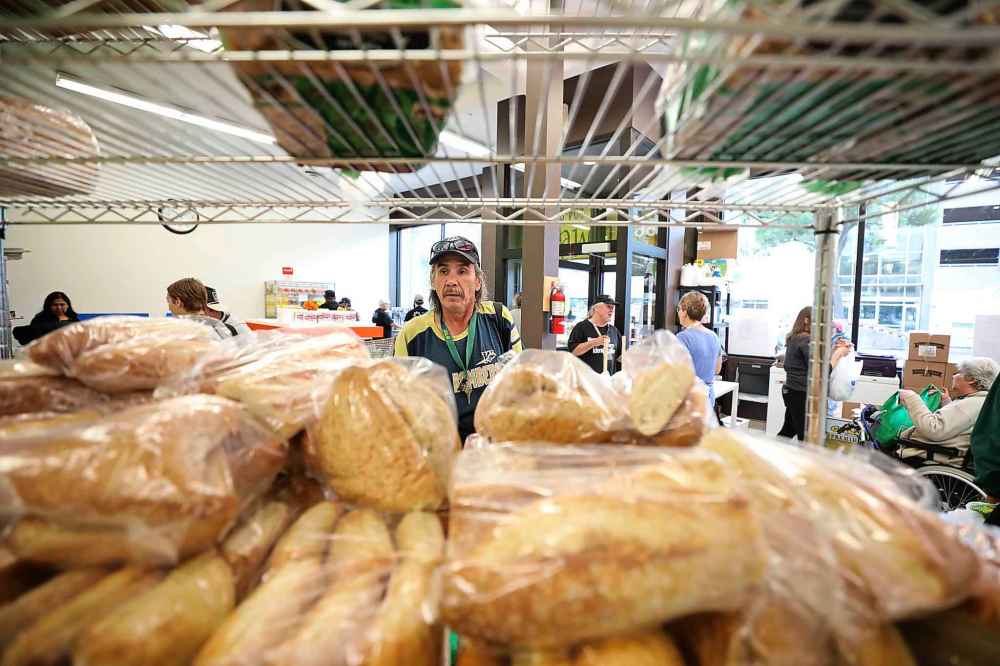
William Van Derbos, a father of two, is shopping to feed his kids.
“Look at this,” he says, gesturing to his reusable bag that’s overflowing with veggies, fruit and, to his delight, “Pork chops!”
“‘‘Cause I got a family, eh?” he says to a reporter who is standing in front of a display of bread. “Can you give me a hand?” he asks, pointing to a loaf on the top shelf. With the bread tucked into his bag, Van Derbos confides that he is glad to pick up meat on this September morning.
“(It will) come in handy when school starts,” he says.
Fresh from finding a spot for 3,000 pounds of donated pork ribs that were delivered minutes before the market opened, Sandra Ingenmey’s eyes are sparkling. She’s pleased with the donation, and that it gave her a chance to solve an organizational puzzle. Before she was the Main Street Project’s co-ordinator of the essentials market, Ingenmey was a professional planner.
“This kind of feeds my own satisfaction, my own need to make sense and create. Organizing is kind of in my blood, so it’s satisfying to me when I see that (something) ran well,” she says.

As for why more people seem to use this particular food bank, “It’s still a mystery,” she says. She wonders, does higher use of the food bank mean more people need it? Or are they choosing this one over others?
“There are many other food banks in the city, but we’re serving this five-block radius of food insecurity. I don’t know what the answer is, whether it’s increased need or it’s the fact that there’s more choice, or if it’s how we’re doing it.”
The approach is simple.
“It’s not rocket science. We’re just serving people with dignity and care, and without judgment,” Ingenmey says.
“It’s all about starting a conversation.”
katie.may@freepress.mb.ca
Twitter: @thatkatiemay
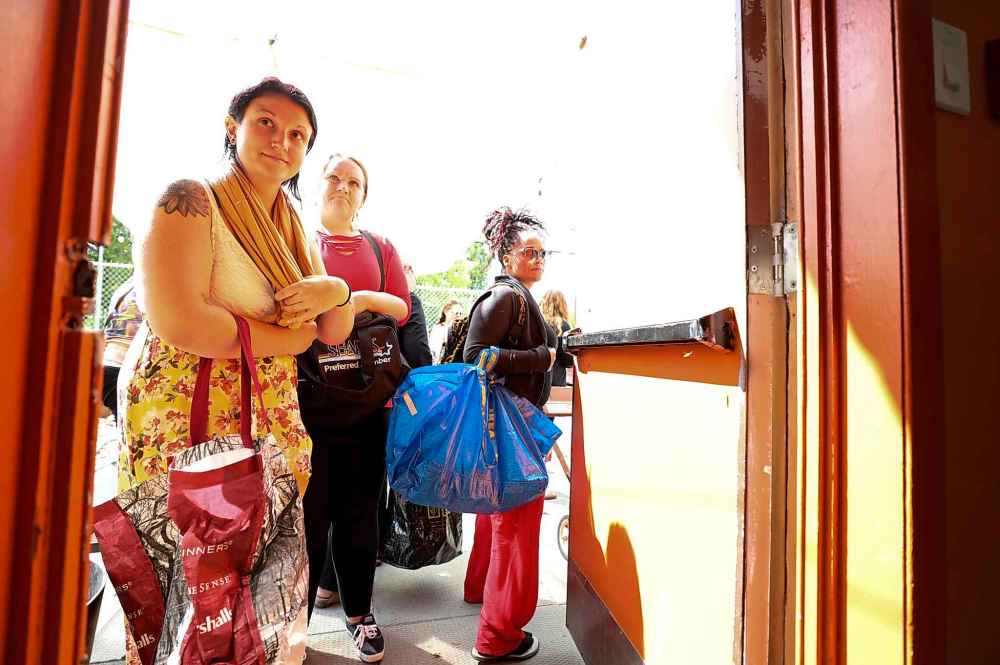

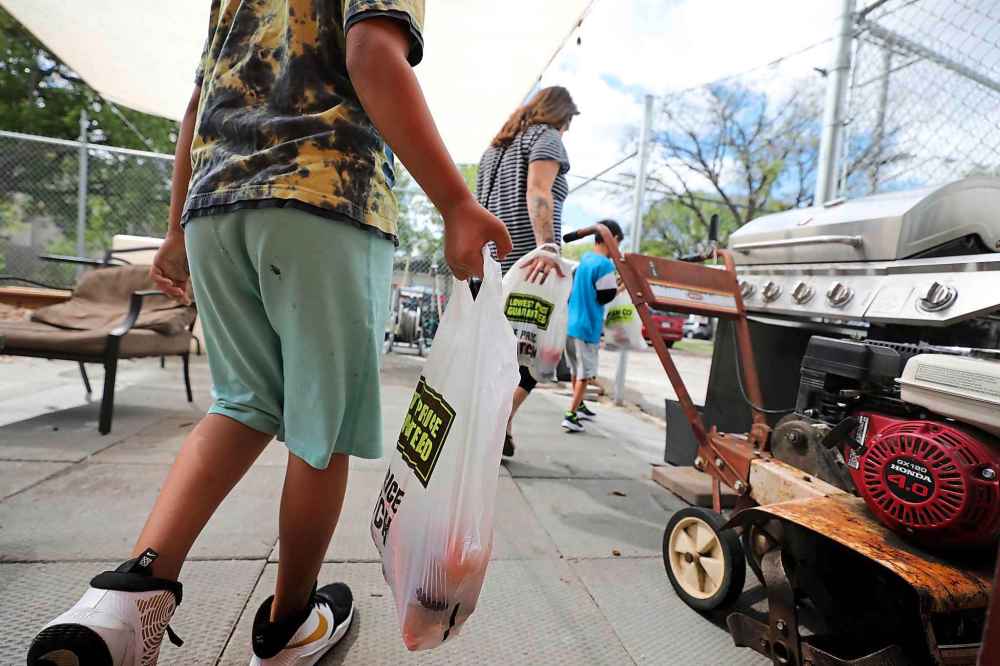

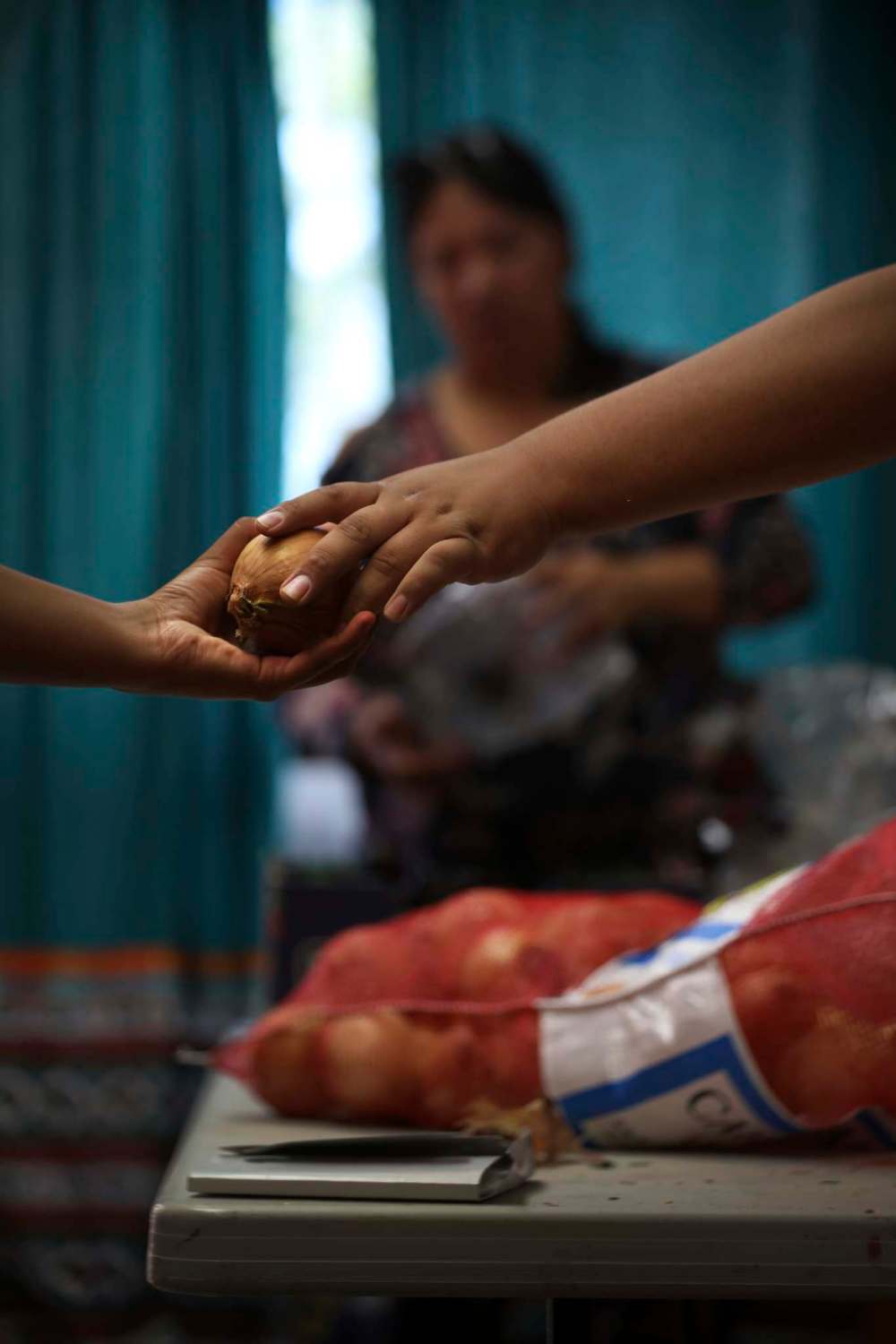



Katie May
Reporter
Katie May is a general-assignment reporter for the Free Press.

Ruth Bonneville
Photojournalist
As the first female photographer hired by the Winnipeg Free Press, Ruth has been an inspiration and a mentor to other women in the male-dominated field of photojournalism for over two decades.
History
Updated on Monday, September 23, 2019 7:10 PM CDT: Corrects pronouns





